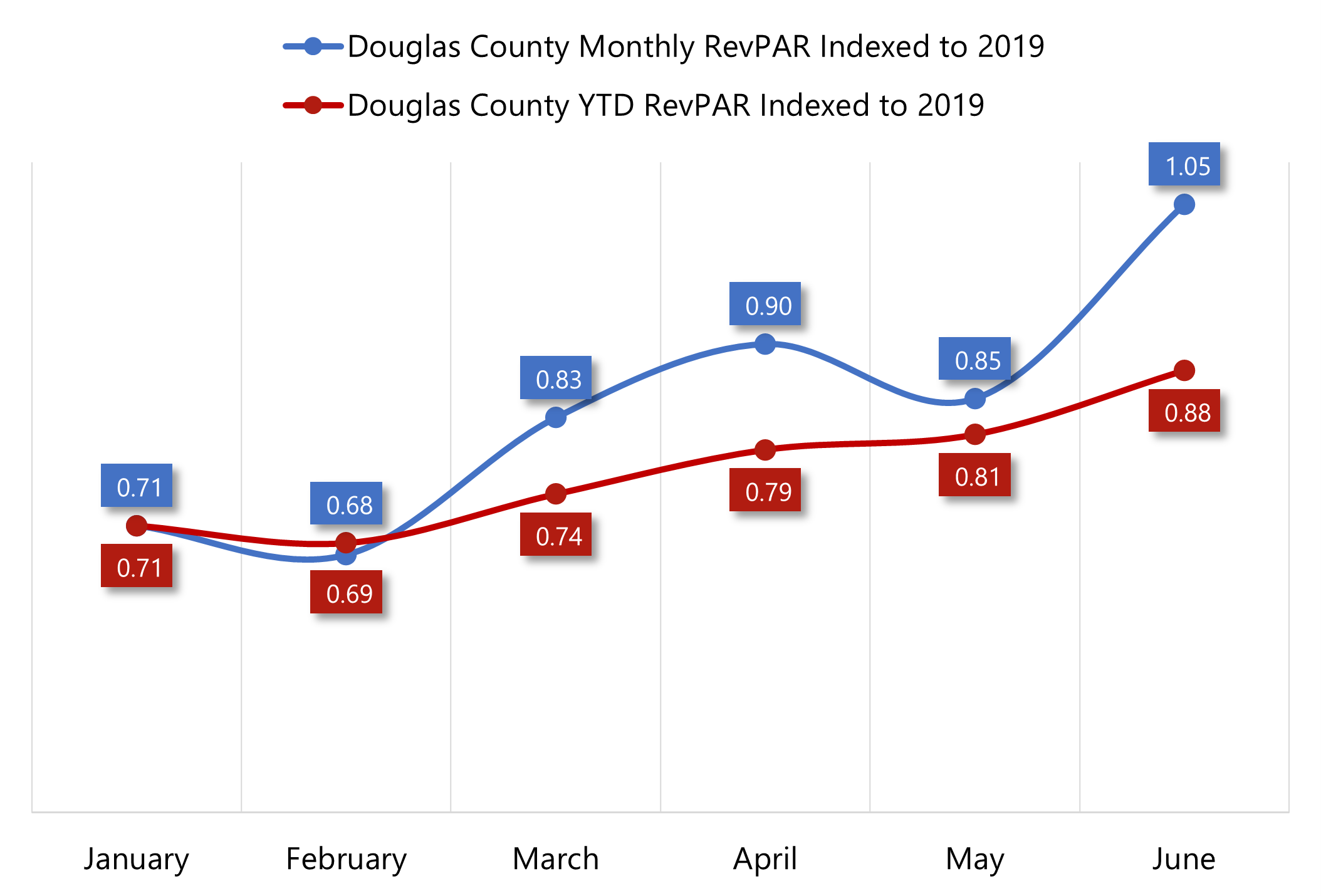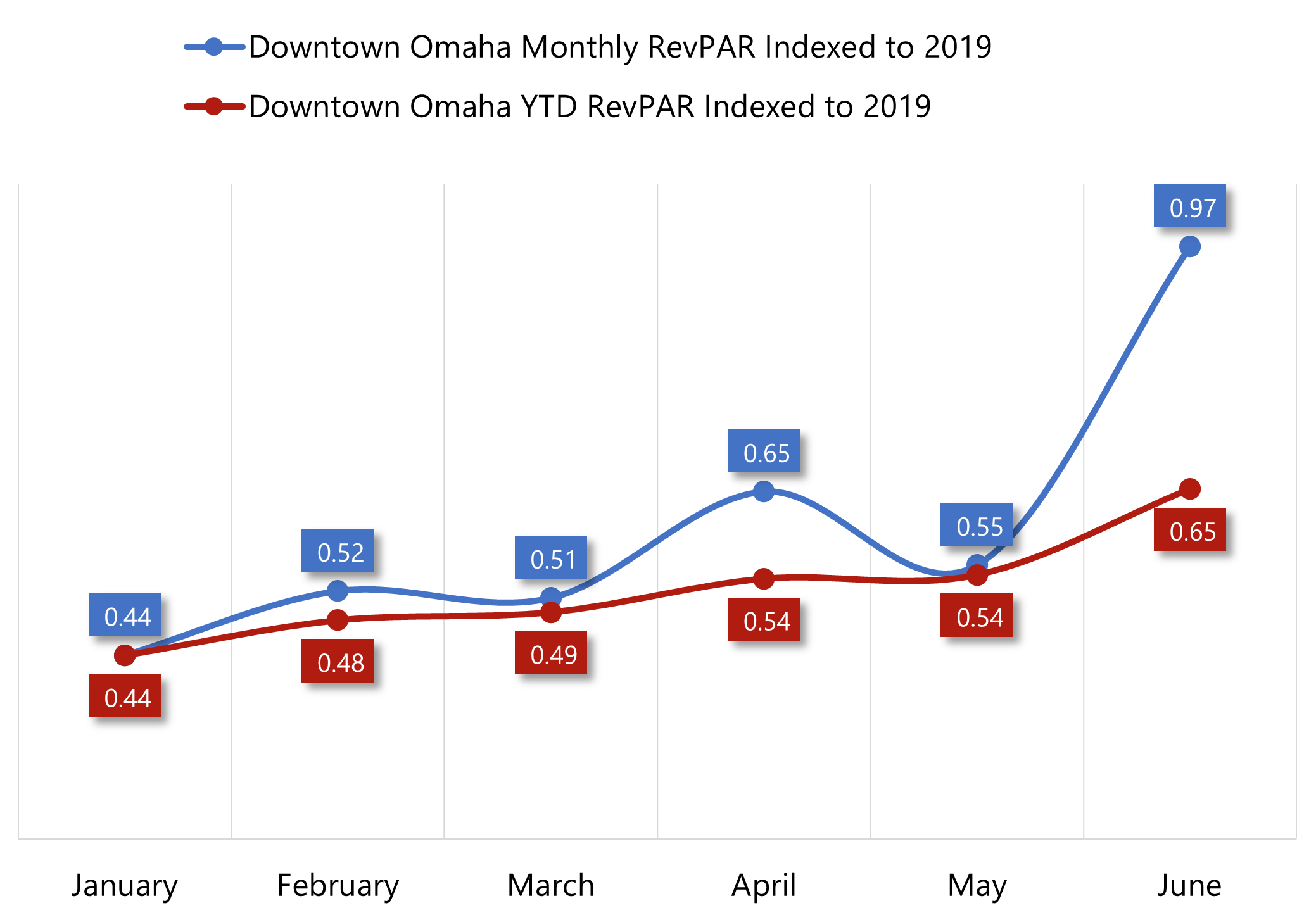 Amid a worldwide pandemic, the lodging industry has been facing a downturn that is greater than the past two lodging-market declines combined. According to STR, Downtown Omaha occupancy levels fell by 53% in 2020, while ADR contracted by 20%. This resulted in the lowest hotel performance metrics for this market ever recorded by STR, with RevPAR dropping roughly 63% in 2020. Similarly, in the greater Douglas County area, annual RevPAR declined approximately 54%, according to county-collected data. With occupancy levels falling to single digits in April 2020 and nearly all group events postponed or canceled in the second quarter of 2020, several of the downtown properties temporarily suspended operations during the second quarter of 2020.
Amid a worldwide pandemic, the lodging industry has been facing a downturn that is greater than the past two lodging-market declines combined. According to STR, Downtown Omaha occupancy levels fell by 53% in 2020, while ADR contracted by 20%. This resulted in the lowest hotel performance metrics for this market ever recorded by STR, with RevPAR dropping roughly 63% in 2020. Similarly, in the greater Douglas County area, annual RevPAR declined approximately 54%, according to county-collected data. With occupancy levels falling to single digits in April 2020 and nearly all group events postponed or canceled in the second quarter of 2020, several of the downtown properties temporarily suspended operations during the second quarter of 2020.Downtown Omaha 2021–2024 Forecast
 Source: STR (Historical Years) and HVS (Forecast)
Source: STR (Historical Years) and HVS (Forecast)

Major factors contributing to the recent trends are summarized as follows:
- While no official “stay-at-home” order was issued in Douglas County, starting on March 14, 2020, Nebraska state and local officials imposed limits on gathering sizes and business activity, restricted travel to essential activities, and recommended that Nebraskans stay home if possible. Hotel demand plummeted in late March, and occupancy levels in Downtown Omaha remained below 15% throughout April and May 2020. ADR levels also declined by over 45% during that period, as higher-rated corporate, meeting, and event demand evaporated and major annual citywide events, such as the Berkshire Hathaway Shareholders Meeting, the Summer Arts Festival, and the NCAA College World Series, were canceled. Select restrictions on indoor dining and small gatherings were lifted in early May 2020; however, many attractions, such as Omaha's Henry Doorly Zoo, remained closed until later in the summer. Capacity limits on indoor gatherings remained in place until February 1, 2021. Although ADR declines diminished and hotel occupancy levels improved to just below 40% over the summer and early fall of 2020, RevPAR declines worsened again in late 2020, as summer and fall sports ended and leisure travel slowed.
- Area corporations that had provided a significant portion of room nights for Omaha hotels, such as Kiewit, Mutual of Omaha, and Union Pacific, rapidly reduced travel and temporarily shifted employees to remote work for much of 2020. While the availability of vaccines and the increased comfort level of travelers have permitted some of this business transient travel to resume in 2021, it remains well below historical levels. This segment continues to be more suppressed than leisure travel in Omaha, similar to many cities across the country. The emergence of the Delta variant is creating more uncertainty about future planning, mask requirements on airlines are discouraging frequent flyers, and a continued mix of remote and in-person workers at area companies is driving the continued use of Zoom meetings when possible. Data from Eppley Airfield illustrate that passenger traffic remains depressed; July 2021 passenger statistics illustrate the best month for travel since March 2020, but that number was still 12% below what was reached in 2019.
Looking beyond 2021, several development projects are ongoing in Downtown Omaha that will enhance the attractiveness of the submarket for visitors, as well as potential new employers and residents.
-
The synchronized redevelopment of the Gene Leahy Mall, the Heartland of America Park, and the Lewis and Clark Landing riverfront began in 2019 and is expected to be completed in phases through 2022 and 2023. The parks are being overhauled through a public–private partnership that will redefine the city’s downtown riverfront.
- In November 2020, construction started on Omaha's new, $101-million riverfront science center, Kiewit Luminarium. This center, located immediately east of the CHI Health Center, is anticipated to open in 2023.
- Being developed by Hines, The Mercantile is a 20-acre, mixed-use redevelopment of the former Conagra World Headquarters in Heartland of America Park. The first phase of the project, which is under construction, includes 375 apartment units, 42,000 square feet of retail space, and an active city plaza that will help connect the Gene Leahy Mall with the riverfront. Future phases will include additional apartment units, office space, and a potential new hotel.
- Additional improvements underway along both the riverfront and the Gene Leahy Mall include a performance pavilion, multiple sand volleyball courts, a boardwalk, a playground, and an "urban beach" with fire pits.
- In May 2021, Omaha Performing Arts broke ground on a new concert venue between 11th and 12th streets along Dodge Street. The Steelhouse Omaha, as it has been named, is expected to be completed in 2023 and will have a 3,000-person capacity.
Total Douglas County vs. Downtown Omaha Submarket Recovery
As noted previously, RevPAR declined more significantly in Downtown Omaha than it did for the greater Douglas County market in 2020. The Downtown submarket accounts for roughly one-third of the hotel room nights in Douglas County but is much more dependent on large group and meeting business, driven in part by the CHI Health Center. This meeting and group business essentially evaporated in 2020.The graphs below illustrate the 2021 RevPAR levels for Douglas County and Downtown Omaha, indexed against the 2019 benchmark RevPAR levels for those same submarkets, showing the monthly indexed data through June 2021, as well as the cumulative year-to-date index.
Douglas County 2021 RevPAR Indexed to Pre-Pandemic 2019 Levels
 Source: Douglas County Department of Revenue, STR
Source: Douglas County Department of Revenue, STR
Downtown Omaha 2021 RevPAR Indexed to Pre-Pandemic 2019 Levels Source: STR
Source: STR

Downtown Omaha 2021 RevPAR Indexed to Pre-Pandemic 2019 Levels

- Both the Downtown Omaha and Douglas County markets illustrate a recovery trend that is improving in year-to-date 2021; however, as the commercial transient and convention business that drives the Downtown submarket has been slow to return, RevPAR levels for the Downtown submarket have remained around half of those in 2019 through much of 2021, while in the greater county area, RevPAR levels as indexed against 2019 are significantly higher.
- Notable RevPAR increases occurred in both April and June of 2021, largely due to the presence of the citywide special events detailed below.
- April 14–24, 2021: NCAA Volleyball Championship Tournament. According to Visit Omaha, when the NCAA moved the entire 48-team field to Omaha, rather than just the Final Four, the estimated number of room nights books jumped from 900 to 9,400.
- June 4–7, 2021, June 13-20, 2021: U.S. Olympic Team Swim Trials. While reduced capacity restrictions were imposed on the 2021 Swim Trials (capped at 8,000 attendees), over 1,400 swimmers from all 50 states qualified for the trials.
- June 19–30, 2021: College World Series. After the CWS was canceled in 2020, the tournament returned in 2021 with no capacity or social-distancing restrictions, setting a new attendance record of 361,711 fans over the entire series (besting the former record of 357,646 set in 2017).
- The city also hosts several youth tournaments, most notably the Triple Crown’s SlumpBuster, which runs concurrently with the CWS, filling up nearly every hotel in the city.
- Given the unusual spike in demand created by June special events, it is unlikely that the remainder of the year will progress with similar recovery levels as those experienced in June. The 2021 recovery should remain stronger through the summer and early fall months, as leisure demand and SMERFE group demand drive hotel business, but the recovery will be tempered as the winter months approach.
Hotel Supply
- Despite the pandemic, several new hotels opened in the Omaha area in 2020 and year-to-date 2021. The most recent additions to the Downtown submarket are the 89-room The Peregrine, a Curio Collection by Hilton hotel, and the 120-room Farnam, an Autograph Collection affiliate; both properties opened in the second quarter of 2021. Farther west, the dual-branded Tru by Hilton and Home2 Suites by Hilton opened in June 2021 with a combined 135 rooms near the 72nd Street and I-80 interchange. An additional two hotel properties, the Hotel Indigo Omaha Downtown and a Moxy by Marriott, are currently under construction in the Downtown submarket and are expected to open within the next twelve months.
- Two full-service hotels, the Sheraton Omaha and the Ramada Plaza Omaha, have permanently closed since the onset of the pandemic. These closures reduced the number of guestrooms available in the greater market by 586 and significantly reduced available convention space outside of the Downtown submarket, as the Ramada Plaza featured a 22,800-square-foot ballroom. Both properties, which were built in the late 1960s and early 1970s, are expected to be redeveloped into new uses.
For more information, contact either member of our Omaha team: Sara E. Olson, MAI, or Daniel P. McCoy, MAI.
About Sara E. Olson, MAI
Sara Olson, MAI is a Senior Vice President and oversees HVS Omaha, overseeing portfolios, major consulting assignments, valuations, market studies and feasibility studies for our valued clients. Sara earned her bachelor's degree in Hotel, Restaurant, and Tourism Management and a minor in Real Estate from the University of Denver. Her prior hospitality-related experience includes front-line work and sales-focused internships at full-service hotels in Colorado and Nebraska. Contact Sara at +1 (402) 690-0407 or [email protected].
About Daniel P. McCoy, MAI
As the HVS Practice Leader for the Midwest, Dan McCoy, MAI, oversees the firm's seven offices in this region. A Senior Managing Director at HVS, Dan is a recognized thought-leader, collaborative advisor, and invaluable resource for the Midwest's lodging industry. He combines a deep understanding of regional hotel markets with strong analytical thinking to provide a wide variety of clients with up-to-date hospitality intelligence and tailor-made solutions. Dan is a Designated Member of the Appraisal Institute (MAI) and a certified general appraiser. Contact Dan at +1 (970) 215-0620 or [email protected].


0 Comments
Success
It will be displayed once approved by an administrator.
Thank you.
Error